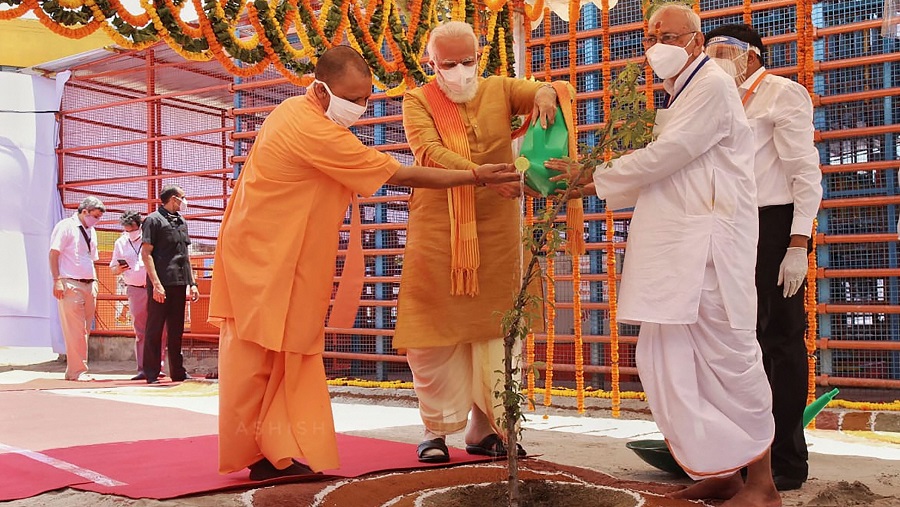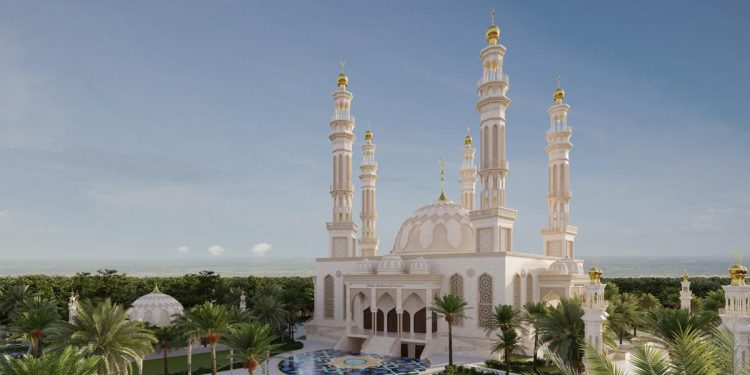By P.K.Balachandran/Daily News
Colombo, January 24: India’s Prime Minister Narendra Modi on Monday consecrated, amidst unprecedented fanfare, an idol of Lord Rama in a grand new temple coming up at Rama’s birthplace in Ayodhya in the North Indian State of Uttar Pradesh.
But even as the consecration was going on, his party, the Bharatiya Janata Party (BJP), with the cooperation of the BJP government in Uttar Pradesh, was planning to build a grand mosque 25 km away on 5 acres of land given by the local government.
The mosque will be named after Prophet Muhammad.
Some recent utterances of Modi and the actions of his government show that he is watering down his “Hindutwa” or Hindu nationalistic politics to reach out to the Muslims and Christians also ahead of the May 2024 parliamentary elections.
Muslims are India’s largest minority accounting for over 200 million in a total of 1.4 billion Indians.
Looking for third consecutive term in the May 2024 parliamentary elections, Modi is eager not to continue his policy of marginalizing the Muslims electorally and relying only on the Hindu vote.
Recently, he sent his Minister of Minorities, Smriti Irani, a Hindu lady, to Medina in Saudi Arabia to get from the Saudi government an enhanced annual quota for Muslim pilgrims going for Haj. He also made a traditional offering (a Chadar) to the shrine of a Sufi saint in Ajmer in Rajasthan State.
However, the mosque that his Muslim followers will be building near Ayodhya will be the most eye catching and politically significant for Modi’s bid to win over the Muslims and end the Congress party’s traditional hold over them.
Portraying Rama as an All-Indian icon
At the consecration of the Rama idol in Ayodhya, Modi portrayed Rama as an all-India figure, not exclusive to the Hindus, his core political constituency.
Modi spoke of Lord Rama not as an embodiment of Hindu consciousness alone, but as an embodiment of a “national consciousness”.
“Ram is not just ours (by which he meant the Hindu majority). He belongs to everyone,” Modi declared. (In North India, Rama is pronounced as Ram).
“This is a temple of national consciousness in the form of Ram. Ram is the faith of India. Ram is the foundation of India. Ram is the idea of India. Ram is the law of India. Ram is the prestige of India. Ram is the glory of India. Ram is the leader and Ram is the policy. Ram is eternal,” Modi said with a flourish.
In India “Ram Rajya” or the “Ram’s Rule” is considered the most just one. Mahatma Gandhi envisioned an independent India that would usher in “Ram Rajya”
Modi made it clear that the India that is being creating by building the temple for Ram is not a mere recreation of the past but a combination of the traditional and the modern.
“Ram temple’s construction is a reflection of Indian society’s maturity. India is now full of positive energy. It will attain prosperity by being guided by tradition and modernity,” he said.
The opening of the temple heralded a “new era” for India, “breaking the shackles of slavery,” he said and added that “the country should rise, taking lessons from the past.”

Modi took a dig at those who had warned that “if the Ram temple was built, then there would be a fire”. PM Modi said the deity is not “fire” but “energy”. He invited all to visit the temple and imbibe its energy.
On his outlook for the future of India he said: “We have to now lay the foundation of India for the next 1,000 years. We take a pledge to build a capable, grand, divine India from this moment.”
Those in India who opposed Modi’s Hindu nationalism boycotted the consecration saying that the head of a “secular” government, Modi should not officiate in a religious ceremony and that he would be breaking this norm with the petty aim garnering Hindu votes in the May 2024 parliamentary elections.
A Grand Mosque
There was a protracted legal dispute over the site on which the Ram temple was to be built. On the site stood a disused 16th. Century mosque built by Mughal Emperor Babar after destroying a Rama temple there. In December 1992, in a fit of revenge and frenzy, a Hindu mob led by BJP stalwarts like L.K.Advani, destroyed the mosque.
But the plan to build a Ram temple on its site was stalled because the matter had been taken to court. In 2019, the Supreme Court ruled that the destruction of the mosque was illegal, but allowed a Hindu organization to build a Ram temple on the site. The court compensated the Muslims by ordering the allocation of 5 acres at a suitable place for a new mosque.
A plot located 25 km away from the heart of Ayodhya, in Dhannipur, was allotted by the government of Uttar Pradesh in February 2020.
In November 2023, the Indo-Islamic Cultural Foundation (IICF), the trust overseeing the construction of the mosque in Ayodhya, appointed Haji Arfat Shaikh, a Bharatiya Janata Party (BJP) leader from Maharashtra State, to do the job. Shaikh is a former Chairperson of the Maharashtra State Commission for Minorities.
The IICF was set up by the Uttar Pradesh government’s Sunni Central Waqf Board.
The mosque will be called Muhammad Bin Abdullah Masjid, after Prophet Muhammad, Sheikh told The Hindu.
The aim is to build one of the biggest mosques of India, “better than the Taj Mahal”, along with “the world’s biggest Quran that will measure about 21 feet”, Shaikh added.
It will also be the first mosque in India to have five minars or towers. A water-and-light show is also being planned.
“We will have water playing in sync with the azan (prayers) inside the mosque. The lights of the mosque will come on at sunset and go off at sunrise automatically. We will also have a giant fish aquarium, bigger than that of Dubai,” Shaikh said.
“The new design by a Pune-based architect, Imran Shaikh, will be ready by the end of February. A brick with verses of the Quran inscribed over it will travel to Madina in the Kingdom of Saudi Arabia (KSA) and to prominent dargahs across India, and will be laid at the mosque site finally,” Sheikh added.
He expects to begin construction in the second half of 2024, after Ramazan.
Special songs are being recorded ahead of the mosque construction, Shaikh said. Vijay Vikram Singh, the voice-over artist made popular by the TV series Bigg Boss, will be engaged to make small videos related to the mosque.
Sheikh said that the IIFC will not go door-to-door for donations, but will launch a website in late February or early March, with QR codes for easy donation.
“Ayodhya is the biggest subject in India and the construction of both the temple and the mosque will end tensions among communities. We will ensure that Ayodhya becomes the finest example of Ganga-Jamuni tehzeeb (the term used for a refined mixture of Hindu and Muslim cultures).”
Sheikh expects that those who visit the Ram temple will also visit the mosque.
END





























































